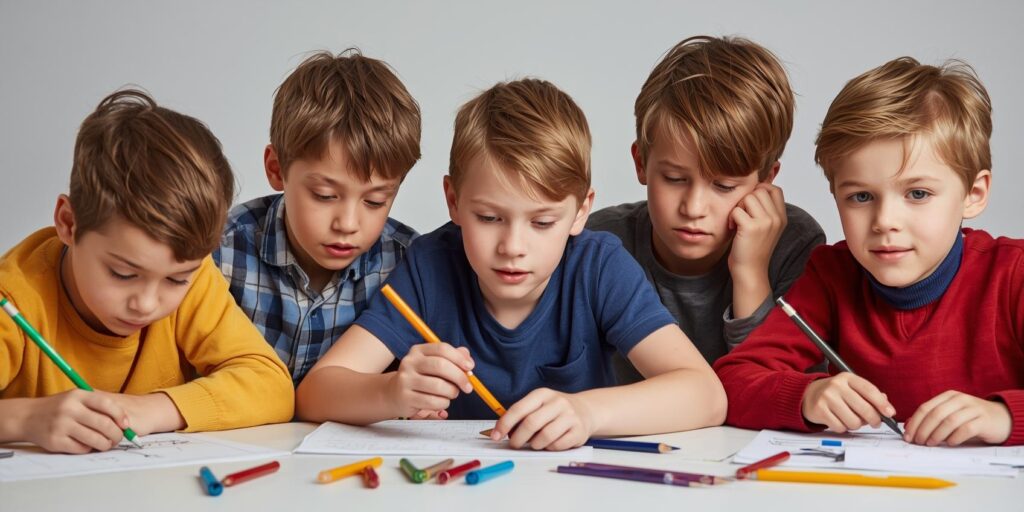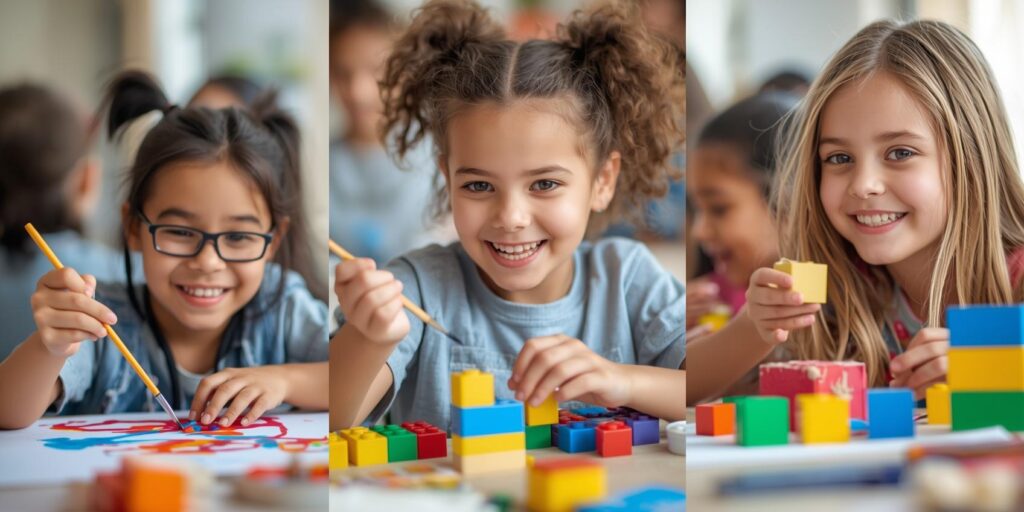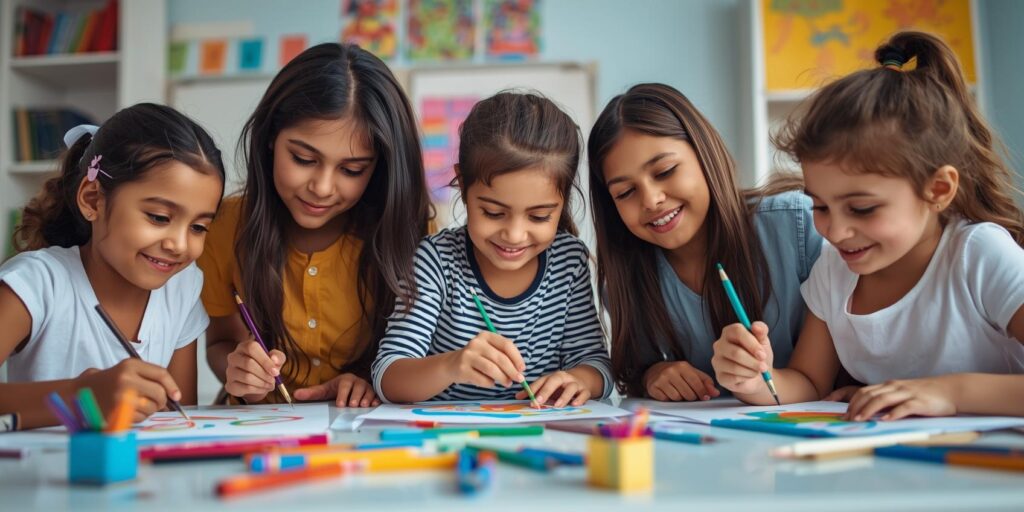
5 Lessons in Creativity from Children
Have you ever watched a child play?
They can turn a stick into a magic wand, a cardboard box into a spaceship, and a blanket into a castle.
To them, the world is not fixed or boring.
It is alive with possibility.
As we grow older, many of us lose this sense of play and imagination.
We get busy. We worry about being “right.”
We learn rules, and sometimes we stop asking “what if.”
But here is the good news: creativity never really goes away.
It just hides under layers of routine, fear, and seriousness.
And the best teachers to help us find it again are children.
In this blog post, we will explore five powerful lessons about creativity that children can teach us.
Along the way, we will look at real-life examples, simple exercises you can try, and ways to bring more childlike wonder into your daily life.

10 Bedtime Stories That Teach Good Habits
5 Lessons in Creativity from Children
So, let’s go through them one by one.

Lesson 1: Curiosity Over Fear
Children are natural explorers.
They ask questions all day long.
“Why is the sky blue?”
“Why do cats purr?”
“What if cars could fly?”
They are not worried about sounding silly.
They are not afraid of being wrong.
They ask because they truly want to know.
As adults, we often lose this habit.
We worry: What if I sound dumb? What if people laugh?
So we stop asking questions.
We stay quiet, even when we are curious.
And when we stop asking, we stop learning.
Think of a child visiting a zoo.
They will point at every animal and ask:
“Why does the giraffe have such a long neck?”
“Do monkeys talk to each other?”
“Can I ride an elephant?”
Now picture an adult at the same zoo.
Many adults just walk, look, and move on.
They admire the animals but rarely ask “why” or “how.”
Creative Takeaway: Ask Bold Questions
If you want to unlock creativity, start asking questions again.
Don’t worry if they sound silly.
Sometimes the silliest question leads to the most interesting idea.
Try this exercise:
- Pick a random object near you (a spoon, a chair, or a plant).
- Ask five “why” questions about it.
- Then ask, “What if?”
For example, a spoon:
- Why is it curved?
- Why do we use spoons instead of forks for soup?
- Why are most spoons made of metal?
- What if spoons were made of chocolate?
- What if spoons could change size to fit any bowl?
Suddenly, your brain is moving in playful directions. That is the power of childlike curiosity.
25 Studio Ghibli Films That Will Change the Way You See Animation
Lesson 2: Play Without Purpose
Children do not need a reason to play.
They build with blocks, not because they want to become architects, but because stacking is fun.
They draw on paper, not because they want to sell art, but because it feels good to make lines and colors.
Adults, on the other hand, often feel guilty if play is not “useful.” We think:
- Will this make money?
- Will this help my career?
- Is this productive?
This way of thinking kills creativity.
When every action must serve a goal, we stop experimenting.
We stop exploring for the joy of it.
Think of children at a playground.
They run, slide, swing, and invent games.
No one says, “But what will you do with this later?” The joy is the point.
Creative Takeaway: Make Time for Play
To be creative, you need to play. Not just work. Not just achieve. Play.
Here are a few ideas:
- Doodle for 10 minutes with no plan. Let your pen wander.
- Make up a silly story starting with “Once upon a time…” and see where it goes.
- Dance in your kitchen to your favorite song.
- Try a new recipe just for fun, even if it fails.
Remember: play is not wasted time. Play is where ideas are born.
Lesson 3: Limitless Imagination
To a child, the world is flexible.
A stick can be a sword, a wand, or a microphone.
A puddle can be an ocean. A chair can be a mountain to climb.
Adults, however, often see things only as they are.
A stick is just a stick. A chair is just for sitting.
But creativity lives in the “what else?”
A chair is not just a chair—it could be a stage, a fort, or even a piece of modern art.
Creative Takeaway: Practice “What If?” Thinking
To stretch your imagination, ask:
- What if this object had a new purpose?
- What if this rule were different?
- What if we swapped roles?
Example: A simple umbrella.
- What if it glowed in the dark to guide you home?
- What if it played music when it rained?
- What if it could fold into your pocket like a handkerchief?
These “what ifs” may sound impossible, but they spark ideas.
Many inventions started as playful imagination.
Airplanes once sounded impossible.
So did cell phones. Someone dared to ask, “What if we could fly?
What if we could talk to anyone, anywhere?” And look where we are now.
Best Books for Young Children in India 2025
Colouring Books: Pack of 12 — Wonder House Books
Lesson 4: Resilience Through Experimentation
Watch a toddler learning to walk.
They fall hundreds of times.
But do they give up? No.
They laugh, cry, wobble, and try again.
Children do not see failure as the end.
They see it as part of learning.
They build a tower of blocks, it falls, and they build again.
Adults, however, often fear failure.
We think, “If I fail, people will judge me.”
If I fail, I’m not good enough.
So we avoid trying new things.
This fear blocks creativity.
Creativity requires risk.
It requires testing, failing, and trying again.
Creative Takeaway: Embrace Mistakes
Instead of fearing mistakes, celebrate them. Each mistake teaches you something new.
Try this mindset shift:
- Instead of saying, “I failed,” say, “I learned.”
- Instead of hiding mistakes, write them down as steps toward progress.
- Instead of stopping after one try, ask, “What can I do differently next time?”
Thomas Edison, the inventor of the light bulb, once said, “I have not failed. I’ve just found 10,000 ways that don’t work.” That is the spirit of a child. That is resilience.
Lesson 5: Joy in Small Things
Children find wonder in the tiniest details.
A bubble floating in the air can bring endless giggles.
A butterfly can stop them in their tracks.
A cardboard box can become a treasure chest.
Adults walk past these same things without noticing.
We rush to work, check our phones, and focus on deadlines.
In our hurry, we miss the small wonders.
But joy in small things fuels creativity.
When you pause to notice, you awaken your imagination.
Creative Takeaway: Practice Wonder
Here are ways to bring back that childlike wonder:
- Take a walk and look closely. Notice shapes, colors, and sounds.
- Watch clouds. What shapes or stories do you see?
- Play with shadows. Make hand puppets or see how your shadow stretches.
- Celebrate tiny wins. Even finishing a puzzle or cooking a meal can be a reason for joy.
The more you notice, the more your brain connects ideas in fresh ways. Wonder is not just for children. It is fuel for everyone.
Bringing It All Together
Children remind us of what creativity truly is:
- Curiosity that asks without fear.
- Play that has no purpose but joy.
- Imagination that sees beyond limits.
- Resilience that treats failure as a step forward.
- Wonder that finds joy in small things.
These are not childish traits.
They are powerful tools for any adult who wants to live a creative life.
The next time you feel stuck, watch a child.
Notice how they play, question, imagine, and bounce back.
Let them be your teachers.
Because inside you, there is still a child who loved to ask, to play, and to dream.
Creativity is not gone. It is waiting for you to let it out again.
Try This Today: A Childlike Creativity Exercise
- Pick one small object in your home.
- Ask five “why” questions about it.
- Then ask three “what if” questions.
- Finally, use the object in a silly, playful way (pretend, draw, or write a story about it).
You may laugh. You may feel silly. That’s the point. You will also feel your creative muscles stretch.
8 Ways to Teach Kids Creative Thinking
More Reasons Why Creativity Matters

Children don’t just teach us lessons in curiosity, play, imagination, resilience, and wonder.
Creativity also shapes how they grow, learn, and connect with the world.
Here are some powerful ways creativity helps:
Model Creativity
Children copy what they see.
If adults show creativity—through art, problem-solving, or even playful thinking—kids learn to do the same.
When you model creativity, you give children permission to try it too.
Encourage Curiosity
Curiosity is the root of learning. Creative activities spark questions and wonder.
When children are encouraged to explore, they keep asking “why,” which helps them grow smarter and braver.
Build Confidence
Creativity helps children trust their own ideas.
When they draw a picture, build a fort, or solve a puzzle, they see that their thoughts matter.
This builds confidence to face new challenges.
Reach Hard-to-Reach Students
Some students don’t respond to regular lessons.
Creativity can reach them in new ways—through music, art, stories, or movement.
For these students, creativity can light the spark that normal lessons miss.
Develop Empathy
When children create stories, role-play, or imagine other perspectives, they learn to step into someone else’s shoes.
Creativity teaches empathy—the ability to care about how others feel.
Improve Decision-Making
Creative play often involves choices.
Should the fort be tall or wide? Should the story end with a dragon or a hero?
These little choices help children practice decision-making in safe, fun ways.
Develop Spatial Ability
When kids build with blocks, draw maps, or put puzzles together, they are using spatial thinking—understanding shapes, sizes, and spaces.
This skill later helps in math, science, and even sports.
Enhance Fine Motor Skills
Activities like cutting, painting, molding clay, or threading beads develop small muscle control.
Fine motor skills are key for writing, drawing, and everyday tasks.
Practice and Improve Social Skills
Creative activities often happen in groups.
When children paint together, act out stories, or build something as a team, they learn how to share, listen, take turns, and solve conflicts.
These skills help them in friendships and beyond.
Conclusion on 5 Lessons in Creativity from Children
Children show us that creativity is not about talent.
It is about mindset. It is about curiosity, play, imagination, resilience, and wonder.
So, the next time you want to feel more creative, don’t buy a new tool or read another self-help book.
Instead, spend time with a child.
Or even better, spend time with the child still inside you.
Ask. Play. Imagine. Try. Wonder.
Creativity is already yours.
Frequently Asked Questions
What are the 5 stages of creative development for children?
The five stages of creative development for children are: scribbling, pre-schematic, schematic, dawning realism, and pseudo-naturalistic. These stages show how kids move from random marks to more detailed, realistic, and expressive creations as they grow.
What are 5 examples of creativity skills?
Five examples of creativity skills are imagination, problem-solving, curiosity, adaptability, and collaboration. These skills help children (and adults) think in new ways, find solutions, and work well with others.
What are the four lessons in creativity?
The four key lessons in creativity are: stay curious, play freely, embrace mistakes, and find joy in small things. These lessons remind us that creativity grows when we explore, experiment, and see the world with wonder.
What are the 5 ways in which one can learn to think creatively?
Five ways to learn to think creatively are: ask more questions, try new experiences, practice brainstorming, play without pressure, and learn from mistakes. These habits open your mind, spark fresh ideas, and help you see problems from new angles.






